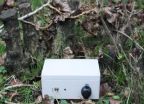(Press-News.org) Two Perelman School of Medicine microbiologists may have found a way to use statins, the well-known blockbuster cholesterol-lowering drugs, to fight the hantavirus, a mysterious and lethal microorganism that appeared suddenly in the US southwest over 20 years ago. That first outbreak led to the deaths of more than a dozen people, most of them in their prime. The last reported outbreak happened in Yellowstone Park in 2012.
Only about 30 known human cases of hantavirus are reported in the US each year. The respiratory syndrome caused by a hantavirus infection comes from breathing in small viral particles in the excrement of infected rodents. It starts out with flu-like symptoms that quickly deteriorate into a dangerous form of adult respiratory distress syndrome. It is among the most deadly known human viruses: 30 percent to 40 percent of people who are diagnosed die from hantavirus pulmonary fever.
A PLOS Pathogens paper by Penn microbiologists Paul Bates, PhD, and Kenneth Briley, PhD, published this month reports that four proteins key to cholesterol synthesis and uptake are highjacked by the hantavirus to enter human host cells. To identify host-cell genes needed for viral replication, Bates and Briley first used a less dangerous virus that was engineered to exhibit some characteristics of a member of the hantavirus group found in South America called Andes virus (ANDV). Although the molecular details are still being deciphered, it appears that adequate cellular cholesterol levels are needed to transport the virus into the cell.
This is not the first time that cholesterol-related proteins have been implicated in viral entry and infection but Bates says, "the hantaviruses seem to be exquisitely sensitive to the cellular cholesterol levels."
The four proteins identified by the Penn researchers are part of a protein complex that regulates cholesterol production in the cells of mammals. They found that treating cells that originated from human airways with an experimental drug that targets one of the four proteins made the cells less susceptible to infection. The experimental drug also lowers cholesterol levels in cells, so Bates wondered whether statins could be used to fight a hantavirus infection.
The researchers found that pre-treatment of human airway cells with a generic statin called mevastatin, which lowers cholesterol by a mechanism that does not involve the four proteins they identified, made the human airway cells less susceptible to ANDV infection. They tested both the experimental drug, PF-429242, and mevastatin, and both were effective against hantavirus, as measured by how many cells are infected with and without the drugs.
Bates surmises that statins might be given after a known hantavirus infection, or even prophylactically to exposed individuals.
Although the drug inhibition studies initially used the engineered virus, Bates used ANDV itself in high-containment Biosafety Level (BSL)-3 facilities in the Department of Microbiology at Penn to confirm that the results were true for ANDV as well. The next step is to test cholesterol-lowering drugs in an animal model for ANDV infection, working with collaborators to perform the animal studies in a BSL-4 at a national facility.
INFORMATION: END
Could statins be used to fight a deadly viral infection?
2014-02-11
ELSE PRESS RELEASES FROM THIS DATE:
Hacking the environment: bringing biodiversity hardware into the open
2014-02-11
New technologies are changing the way we collect biodiversity data. Data that once required taking expensive, bulky and fragile equipment on field trips can now be collected on cheap, compact and robust devices. In a recent paper in the Biodiversity Data Journal the construction of an environmental data-logger using the Arduino platform is described. It is hoped that this work will encourage the adoption of new data collection technologies by biodiversity scientists and foster new collaborations with both electronics hobbyists and electronics engineers who have an interest ...
Exon skipping prevents formation of toxic protein fragments in Huntington's disease
2014-02-11
New Rochelle, NY, February 11, 2014—An innovative therapeutic strategy for reducing the levels of toxic protein fragments associated with Huntington's disease uses a new approach called exon skipping to remove the disease-causing component of the essential protein, huntingtin. Proof of concept using antisense oligonucleotides to "skip over" the specific exon in a mouse model of Huntington's disease is reported in an article in Nucleic Acid Therapeutics, a peer-reviewed journal from Mary Ann Liebert, Inc., publishers. The article, part of a special focus issue on exon skipping, ...
Excess weight linked to brain changes that may relate to memory, emotions, and appetite
2014-02-11
Being overweight appears related to reduced levels of a molecule that reflects brain cell health in the hippocampus, a part of the brain involved in memory, learning, and emotions, and likely also involved in appetite control, according to a study performed by researchers at SUNY Downstate Medical Center and other institutions. The results of the study were published in Neuroimage: Clinical.
Jeremy D. Coplan, MD, professor of psychiatry at SUNY Downstate, led a multicenter team that visualized the molecule, N-acetyl-aspartate (NAA), using magnetic resonance spectroscopy, ...
RI Hospital: Cognitive behavioral therapy benefits patients with body dysmorphic disorder
2014-02-11
PROVIDENCE, R.I. – In a recent study, researchers at Rhode Island Hospital found significant benefits of cognitive behavioral therapy as a treatment modality for patients with Body Dysmorphic Disorder (BDD). BDD is a common, often severe, and under-recognized body image disorder that affects an estimated 1.7 percent to 2.4 percent of the population. This study demonstrated significant improvement in patients' BDD symptoms and level of disability, as well as high levels of patient satisfaction with the treatment. The study is published online in advance of print in the journal ...
Source of 'moon curse' revealed by eclipse
2014-02-11
Strange events have long been linked to nights of a full moon, though careful scrutiny dispels any association. So, when signals bounced off the lunar surface returned surprisingly faint echoes on full moon nights, scientists sought an explanation in reason rather than superstition. Still, the most compelling evidence arrived during another event that once evoked irrational fears—on a night when Earth's shadow eclipsed the full moon.
Tom Murphy, a physicist at UC San Diego, is among the scientists who have aimed laser beams at suitcase-sized reflectors placed on the moon ...
Study: Resilience in parents of children undergoing stem cell transplant
2014-02-11
A child's illness can challenge a parent's wellbeing. However, a study recently published in the journal Biology of Blood and Marrow Transplantation shows that in the case of a child's stem cell transplant, parents feel increased distress at the time of the procedure, but eventually recover to normal levels of adjustment.
"Across all study groups, what we basically showed is that parents are resilient. Overall, parents get better over time," says Jennifer Lindwall, PhD, assistant professor of psychiatry at the CU School of Medicine, teaching partner of the University ...
Data on today's youth reveal childhood clues for later risk of STDs
2014-02-11
Here's yet another reason to focus on kids' early years. Children who grow up in well-managed households, enjoy school, and have friends who stay out of trouble report fewer sexually transmitted diseases in young adulthood, according to a new analysis.
The findings, from University of Washington longitudinal surveys of nearly 2,000 participants, suggest that efforts to curb the spread of sexually transmitted diseases should begin years before most people start having sex.
"Pay less attention to the sex aspect of this and think of the larger context," is lead author ...
Targeting tumors: Ion beam accelerators take aim at cancer
2014-02-11
EVENT: Advances in the design and operation of particle accelerators built for basic physics research are leading to the rapid evolution of machines that deliver cancer-killing beams. Hear about the latest developments and challenges in this field from a physicist, a radiobiologist, and a clinical oncologist, and participate in a discussion about cost, access, and ethics at a symposium organized by the U.S. Department of Energy's Brookhaven National Laboratory ("Targeting Tumors: Ion Beam Accelerators Take Aim at Cancer") and at a related press briefing--both to be held ...
Nanoparticles treat muscular dystrophy in mice
2014-02-11
Researchers at Washington University School of Medicine in St. Louis have demonstrated a new approach to treating muscular dystrophy. Mice with a form of this muscle-weakening disease showed improved strength and heart function when treated with nanoparticles loaded with rapamycin, an immunosuppressive drug recently found to improve recycling of cellular waste.
The study appears online in The FASEB Journal.
The investigators, including first author Kristin P. Bibee, MD, PhD, looked at a mouse model of Duchenne muscular dystrophy, the most severe inherited form of the ...
Child abuse rises with income inequality, study shows
2014-02-11
ITHACA, N.Y. – As the Great Recession deepened and income inequality became more pronounced, county-by-county rates of child maltreatment – from sexual, physical and emotional abuse to traumatic brain injuries and death – worsened, according to a nationwide study by Cornell University.
The income inequality-child maltreatment study, to be published in the March 2014 edition of the peer-review journal Pediatrics, covers all 3,142 American counties from 2005-09, and is one of the most comprehensive of its kind and the first to target child abuse in places with the greatest ...



